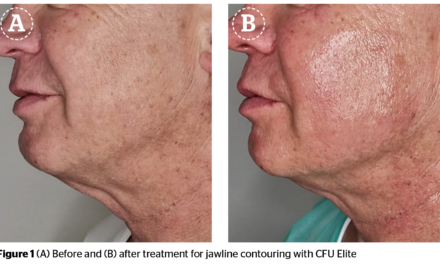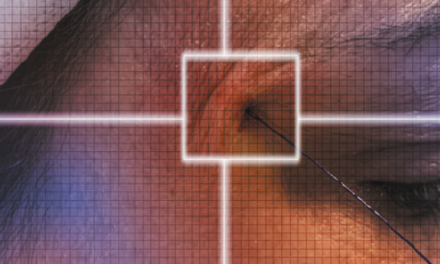Yi-Shan Tsai, Chia-Meng Yu, and Kwang-Yi Tung share the results of their case series on the safety and efficacy of combined energy for skin tightening in Asian patients
Non-invasive cosmetic treatments, especially energy-based devices and skin tightening platforms, have become well-established and are becoming ever more popular in Asia. A common issue for Asian skin is ageing skin and patients would generally prefer a gentle treatment with minimal downtime and side-effects. elōs Technology (Electro-Optical Synergy) combines radiofrequency (RF) energy with the optical energy of laser and IPL devices. This combination can provide better results with a higher degree of safety than either technology individually. Decreasing optical energy and substituting RF for the shortfall provides a way to selectively heat the targeted chromophore with minimal risk of skin damage and a high-degree of accuracy. Since RF is not directed to the melanin, patients of all Fitzpatrick skin tones can be addressed.
The applicator combines gentle pulsed infrared light (wavelengths 700–2000 nm) and bi-polar RF to provide bulk heat to the dermis creating deep dermal heating. The infrared light and RF heats both the superficial and deep dermis, 1–3 mm of skin layers, to treat wrinkles and create a skin tightening response. As the dermis loses collagen and elastin, it results in a loss of dermal volume and skin sagging. The applicator initiates collagen shrinkage at around +/-43°C leading to collagen contracture and remodelling, resulting in both immediate and long-term skin tightening.
Patients
This was a prospective clinical study performed at one Taiwan centre. Eleven patients, including nine women and two men, were recruited into the study. Patient ages ranged from 33 to 66 years (mean age was 44) with Fitzpatrick skin type III and IV, and Glogau wrinkle scale I-III. Patient exclusion criteria were keloid, pregnancy, breastfeeding, collagen diseases, dermal filler injections, neurotoxin injections, Sculptra injection, Ellanse injection and laser phototherapy received within the past 6 months.
Device description and treatment protocol
The treatment devices are the elōs Plus® platform and Sublime applicators (Candela Corporation, Wayland, MA). All 11 patients received treatments to their middle, lower face, and submental areas. The forehead was spared. Patients received three treatment sessions at approximately 4-week intervals, consecutively three times. The middle and lower face treatments for patients were programmed into three steps (Figure 1). Step one: moving in a curve from the central chin to the ear and parallel to the submental line. Each pass overlaps by 10%. Step two: moving vertically from the lower face to the upper face but stop at the infra-orbital rim. Each pass overlaps by 10%. Step three, moving in a V-Shape from the angle point near the posterior border of depressor anguli oris muscles. Again, each pass overlaps 10%. Additionally, for obese patients or those with a droopy fat pad at the submental area, treatment was also performed on the submental area.
Clinical assessments
Pre-treatment photos were taken before each treatment and at 4, 12, and 36 weeks after the last treatment. A digital camera was used (Canon EOS 700D, Tokyo, Japan). The photos were evaluated by two dermatologists regarding compactness, brightness, and overall improvement of the face. The patients were also asked to fill a questionnaire after each treatment session.
Results
A total of 11 patients were treated. An evaluation was completed at one and three months post-treatment. All patients tolerated the treatment well with topical anaesthesia. In terms of side-effects, patients only experienced minor erythema and micro-crusts. The erythema lasted for 1–2 days after treatment. RF can effectively improve the definition of the submental line by lifting the drooping fat pads and recontouring the face for an improved and younger look (Figure 2–3).
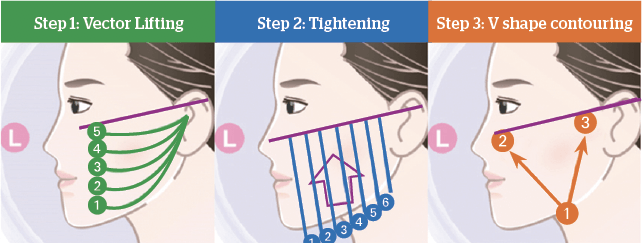
Figure 1 Movement of the Applicator in 3 Steps
Two dermatologists performed blinded evaluations of the improvement of skin tightening from the photos at baseline and 3 months after last treatment. The Global Aesthetic Improvement Scale (GAIS) was used (0 = no improvement; 1 = minimal improvement; 2 = moderated improvement; 3 = significant improvement; 4 = very significant improvement).
Patients completed a questionnaire to review their improvement, satisfaction, and post-treatment side effects. The Satisfaction Scale ranged from Very Dissatisfied (-2) to Very Satisfied (2). All patients reported 0 or above (No Opinion, Satisfied or Very Satisfied). A total of 90.9% of patients were either Satisfied or Very Satisfied after their first and third treatments; 81.8% experienced the same satisfaction levels after their second treatment. Results from ten of the eleven patients that had completed their 3-month follow-up showed 90% were still Satisfied or Very Satisfied. Most patients (72.7%) had reported no post-treatment side-effects after their first treatment. After their third treatment, 64% reported no post-treatment side-effects with 27% reported mild effects and the remaining 9% (n=1/11) considered experiencing a moderate side-effect.
Discussion
Improvement in skin laxity is a significant concern for middle-aged Asian patients. Among many available devices, the desired platform is one that achieves both an effective clinical outcome and patient satisfaction1. Particular attention is required for pigmentation issues for people of colour after inflammation regarding photoelectric treatments. elōs Plus® is suitable to treat all skin types as the radiofrequency is chromophore independent and not selectively absorbed by melanin.
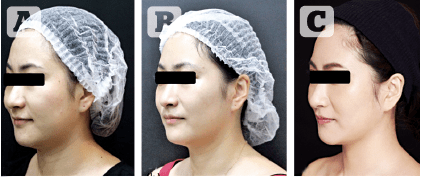
Figure 2 A 34-year-old female received three sessions of treatments. (A) Baseline; (B) 3 months after third treatment; (C) 9 months after third treatment. Note tightening of submental line and firming
Previous studies have demonstrated that treatments can reduce sagginess, improve facial contours, and achieve facial rejuvenation effectively2,3. The analysis of histological structures also confirmed that neo-collagen synthesis took place after the electro-optic synergy procedure4. A fractional bipolar RF device combined with a bipolar RF and infrared light treatment are reported to improve facial wrinkles and overall facial skin tone, and texture as well as improve photo-damaged hands5,6.
In this study, a new strategy of combined operation is proposed as the operation direction in this combination
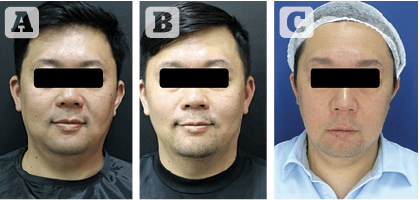
Figure 3 A 44-year-old male received three sessions of treatments. (A) Baseline; (B) 3 months after third treatment; (C) 9 months after third treatment. Note tightening of submental line and firming
may achieve a better lifting effect and save more time with the same amount of energy as previously combined operations, while side-effects will not increase. It is speculated that such results are due to vertical and horizontal uniform operation allowing the tissues to accept RF evenly; and the V-shape vector can create a ‘hook’ effect, by holding the loose tissues and effectively lifting them.
An immediate effect after treatment was observed, which hasn’t been mentioned in previous studies. When the patient sat up after half-face treatment, there was a significant difference in skin laxity compared to their other un-treated half. The treated area was more compact with more concentrated cheek fat, shallow nasolabial folds, and the submental line of some patients was more defined. Such an immediate comparison gave the patients an objective result comparison, thus improving patients’ trust and satisfaction for the treatment. It is speculated the instant effect is associated with the compact reaction of tissues after exposure to heat. The results 3 months after the procedure demonstrated an increase in collagen.
It is also recommended an incremental energy increase programme may be planned for the subsequent treatments and the energy may be increased gradually at the second and third sessions as patients’ tolerance may be higher. However, if the patient is sensitive to the treatment, proper energy programming should be provided based on the patient’s reaction to avoid scalding.
In summary, elōs Plus® treatment with Sublime applicator in three directions can lift and compact the face effectively. The small patient population limited the study. We look forward to the results of a larger scale study in the future.
Declaration of interest Funding for submission of this paper was provided by Candela
Figures 1 © Candela Medical; 2-3 © Dr Yi-Shan Tsai



